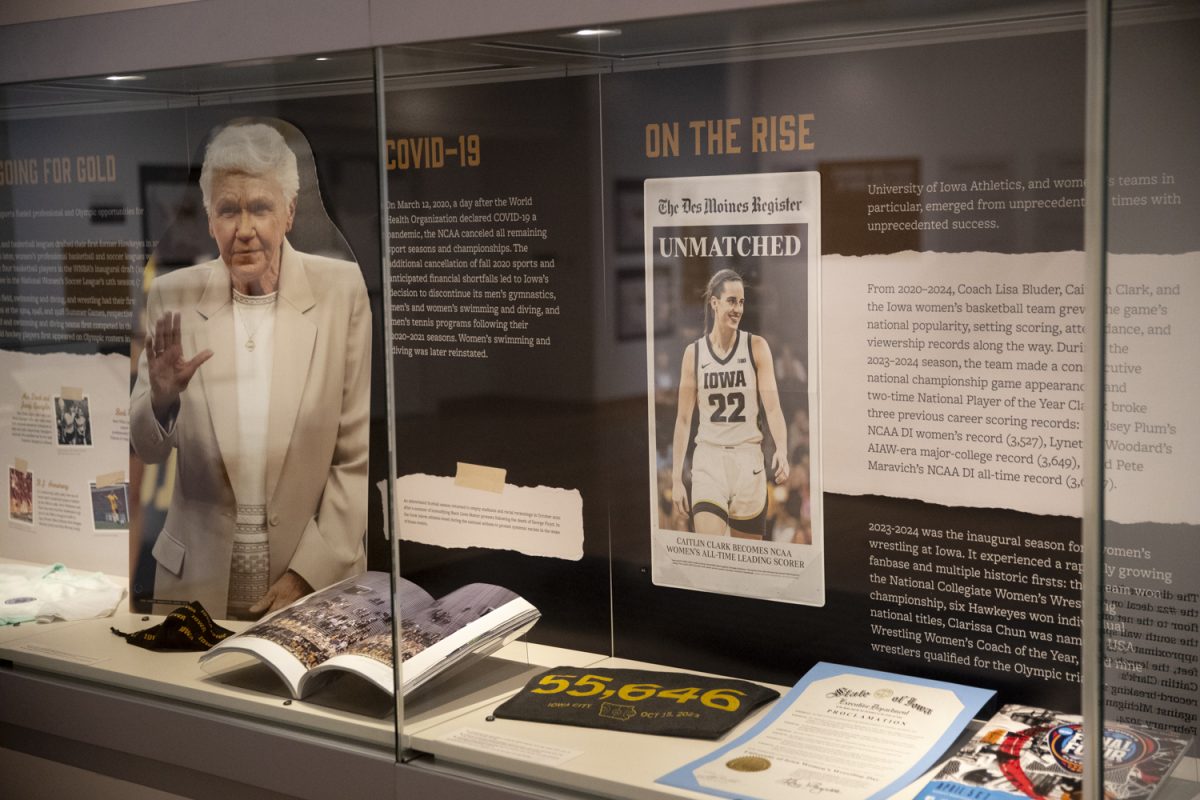Students, faculty, Iowa City residents, and Hawkeye fans alike have been privileged to witness some great Iowa college athletes throughout past years, including Caitlin Clark, Cooper DeJean, and Spencer Lee.
But what about those prior? What about the previous athletes who helped shape the culture of Iowa sports way back when?
University of Iowa Associate Professor of Instruction of Sport and Media Culture Jennifer Sterling and Exhibition and Engagement Coordinator Sara Pinkham put together the “Hawkeye Histories, Sporting Stories” exhibit, displaying many pivotal events across all Iowa sports dating back to the early 1900s.
The exhibit has been sitting in the Main Library Gallery near the east entrance since Aug. 26 and will stay open until Dec. 19.
“I just kind of wanted to bring a more comprehensive… more representative history to light and just have people have a little bit of knowledge about all these really unique things to Iowa,” Sterling said. “Iowa was really involved in a lot of the major shifts in intercollegiate athletics.”
Sterling leads many courses that teach students about the history of sports, such as Inequality in American Sport and Sport and Globalization. It was only some years ago when she came up with the idea for an Iowa sports history exhibit.
She spent a great amount of time doing extensive research on the history of Hawkeye athletics, digging up any new information she could find.
“The first major step was getting into the archives and doing research,” Sterling said. “I researched across the university archives and the Iowa women’s archives and then the Iowa Digital Library. One of the first things I did was literally flip page by page through each of the yearbooks just to get an idea of the timeline to start collecting images that moved me in particular ways.”
For an exhibit to be displayed in the Main Library Gallery, the exhibition curator puts in a proposal to a committee that consists of representatives from the Stanley Museum of Art and the Pentacrest Museums — typically a few years prior.
A unanimous decision must take place for the exhibit to be approved. Sterling gathered enough information to earn unanimous support from the committee.
“The main point of the Main Library Gallery is to be able to show off the things that we have in our collections here at the libraries within the context of the story,” Pinkham said. “We went into production about a year and a half ago … That’s where I come in, and the rest of the exhibit team comes in to bring it to life.”
The exhibit features some historic moments in not just Iowa sports, but sports overall.
Many of the antique items on display were loaned from the Iowa Special Collections and Archives or the Athletics Hall of Fame. Among those items include letters written on a typewriter, black and white pictures, name tags, and historical books.
“Dr. Sterling has been researching using our archives for many years, so she kind of already had an idea of some of the things that she wanted to put into the exhibit,” Pinkham said. “This is a really great way to pull some of those things out and put them within the context of a story.”
Due to limited space, not everything Sterling came across was put on display. For example, the 1956 men’s basketball National Championship game between Iowa and San Francisco featured former NBA superstar and basketball pioneer Bill Russell, but there wasn’t enough room in the exhibit to include that information.
“Not everything can make the cut,” Sterling said. “It was really mostly little things, stories that I didn’t expand upon as much as I wanted to or could’ve … But there’s only so much space in a physical exhibit.”
But one thing that Sterling was looking to do with this exhibit was emphasize the rich history of women’s athletics at Iowa.
“There were stories that I knew I wanted to put in,” Sterling said. “[I] had to talk about some of the lawsuits and challenges that women athletics have made, particularly here.”
In Washington, D.C., sits the Smithsonian National Museum of African American History and Culture, or NMAAHC — the world’s largest museum dedicated to African-American history and culture.
Damion Thomas, a sports curator at the NMAAHC, visited to Iowa City to hold a lecture on Oct. 8 to talk about his museum and the importance of learning about the history of sports.
“This is important because when I think about what my mission is, it is to use history to inspire, to uplift and encourage you,” Thomas said. “What I try to do with my history is to defend the honor, humanity, and brilliance of life. And it’s those things that really compel me to have to do this kind of thing.”
He got the chance to visit Sterling’s Iowa exhibit and said he was very impressed. He advises students to take advantage of the exhibit and learn about the school’s rich sporting history while it’s here.
Even after it’s removed, a virtual copy of the “Hawkeye Histories Sporting Stories” exhibit will be made and posted on the university website.
“I think this is really important because it’s important to share local history and local stories as well and how it is that you frame things,” Thomas said. “Change doesn’t happen because time passes. It happens because people push and bite and claw and demand to be heard. And that’s one of the great things I like about the exhibition, is that it really emphasizes some of those stories.”



